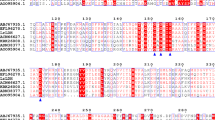Summary
A new dehydrogenase from Lactobacillus confusus has been purified. The following reactions are catalyzed by this enzyme:
Various 2-ketocarboxylic acids are stereospecifically reduced to the corresponding l-2-hydroxycarboxylic acids. In the reverse reaction the NAD dependent dehydrogenation of l-2-hydroxycarboxylic acids is observed. l-2-hydroxyisocaproate seems to be the best substrate for this enzyme which we therefore call l-2-hydroxyisocaproate dehydrogenase (l-HicDH). The enzyme requires NAD(H) as a cofactor, which cannot be replaced by NADP(H). The large scale purification of the enzyme is described starting with 24 kg wet cells, it involved homogenization using a continuously operating high speed bead mill, liquid-liquid extraction with aqueous two-phase systems and diafiltration followed by ion-exchange chromatography on DEAE-cellulose. At this stage the enzyme was purified 177-fold resulting in a specific activity of 30 U/mg. This technical catalyst can be used for the continuous production of l-2-hydroxycarboxylic acids in an enzyme membrane reactor. Further purification up to 450–480 U/mg can be carried out by interfacial salting out chromatography or affinity chromatography, respectively. Properties of the purified enzyme were investigated in detail especially the parameters which are important for an industrial application.
Similar content being viewed by others
References
Andrews P (1965) The gel filtration behaviour of proteins related to their molecular weights over a wide range. Biochem J 96:595–606
Bradford MM (1976) A rapid and sensitive method for the quantitation of microgram quantities of protein utilizing the principle of protein-dye binding. Anal Biochem 72:248–254
Bückmann AF, Kula MR, Wichmann R, Wandrey C (1981) An efficient synthesis of high-molecular-weight NAD(H). J Appl Biochem 3:301–315
Haar von der F (1976) Purification of protein by fractional interfacial salting out on unsubstituted agarose gels Biochem Biophys Res Commun 70:1009–1013
Hummel W, Schütte H, Kula MR (1983) Large-scale production of d-lactate dehydrogenase for the stereospecific reduction of pyruvate and phenylpyruvate. Eur J Appl Microbiol Biotechnol 18:75–85
Jovin T, Chrambach A, Maughton MA (1964) An apparatus for preparative temperature-regulated polyacrylamide gel electrophoresis. Anal Biochem 9:351–369
Kroner KH, Schütte H, Stach W, Kula MR (1982) Scale-up of formate dehydrogenase by partition. J Chem Tech Biotechnol 32:130–137
Kula MR, Kroner KH, Hustedt H, Schütte H (1981) Technical aspects of extractive enzyme purification. In: Costantinidis A, Vieth WR, Venkatasubramanian K (eds) Biochem Eng II. Ann NY Acad Sci 369: 341–354
Kula MR, Kroner KH, Hustedt H (1982) Purification of enzymes by liquid-liquid extraction. Adv Biochem Eng 24:73–118
DeMan JC, Rogosa M, Sharpe ME (1960) A medium for the cultivation of lactobacilli. J Appl Bacteriol 23:130–135
Meister A (1950) Reduction of α,γ-Diketo and α-Keto acids catalyzed by muscle preparations and by crystalline lactic dehydrogenase. J Biol Chem 184:117–129
Sawada T, Ogawa M, Ninomiya R, Yokose K, Fujin M, Watanabe K, Suhara Y, Maruyama HB (1983) Microbial resolution of α-hydroxy acids by enantiospecifically dehydrogenating bacteria from soil. Appl Environ Microbiol 45:884–891
Shapiro AL, Vinuela E, Maizel JV (1967) Molecular weight estimation of polypeptide chains by electrophoresis in SDS-Polyacrylamide gels. Biochem Biophys Res Commun 28:815–820
Wichmann R, Wandrey C, Bückmann AF, Kula MR (1981) Continuous enzymatic transformation in an enzyme membrane reactor with simultaneous NAD(H) regeneration. Biotechnol Bioeng 23:2789–2802
Wichmann R, Wandrey C, Leuchtenberger W, Kula MR, Bückmann AF (1982) Deutsche Offenlegungsschrift DOS 2930087.6, US-Patent 4.326.031 vom 20.4.1982. Verfahren zur herstellung von optisch aktiven α-Hydroxycarbon-säuren
Wichmann R, Hummel W, Schütte H, Bückmann AF, Wandrey C, Kula MR (1983) Enzymatic production of optically active 2-hydroxy acids. In: Laskin A (ed) Enzyme engineering VII. Ann NY Acad Sci (in press)
Author information
Authors and Affiliations
Rights and permissions
About this article
Cite this article
Schütte, H., Hummel, W. & Kula, M.R. l-2-hydroxyisocaproate dehydrogenase—A new enzyme from Lactobacillus confusus for the stereospecific reduction of 2-ketocarboxylic acids. Appl Microbiol Biotechnol 19, 167–176 (1984). https://doi.org/10.1007/BF00256449
Received:
Issue Date:
DOI: https://doi.org/10.1007/BF00256449




